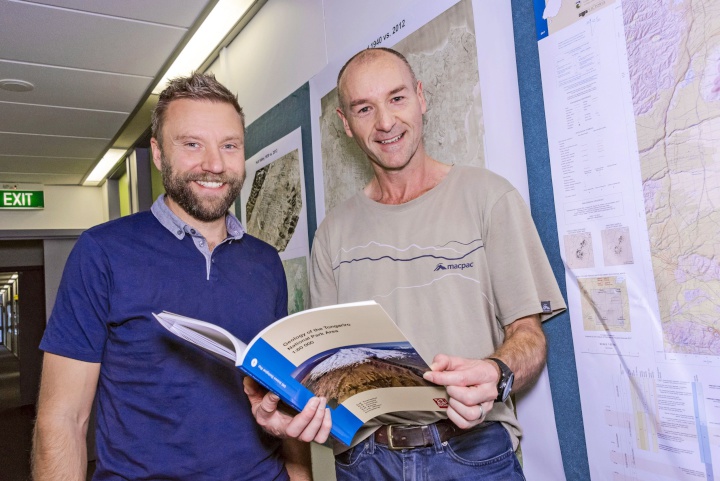New geological map of Tongariro National Park
21 AUGUST 2018
New geological map of Tongariro National Park the first of its kind

A newly published geological map of Tongariro National Park brings new insights to the geological formation and volcanic history of this World Heritage Area.
The production of the Geology of the Tongariro National Park area was a collaboration involving GNS Science, the Department of Conservation, and Victoria University of Wellington.
The publication consists of a large 1:60,000 scale geological map and a beautifully illustrated 109-page companion book. The folded map is tucked into a sleeve in the back page of the book.
The map and book describe the geological history and structure of all the volcanoes in the park in detail. They are aimed at the technically-inclined public reader and are designed to encourage further scientific studies.
The volcanoes of Tongariro National Park – Tongariro, Ruapehu, and Ngauruhoe - have a rich history of eruptive activity for about one million years and the research undertaken to produce this publication has resulted in a better understanding of their life cycles and the hazards they pose.
“The map includes a substantial revision of our ideas about the ways these iconic dual World Heritage Area volcanoes have built themselves,” says GNS Science geologist and co-author of the map Dougal Townsend.
“This revision has enabled a new picture to be gained of the evolution of the magma systems below Ruapehu and Tongariro.”
The main advance on existing understanding is on the extent to which ice-caps and glaciers have controlled the ways in which lava flows of the volcanoes have built the mountains during the last 250,000 years.
Complex volcanic flows and eruption activity have been unravelled with the help of many new precise radiometric dates and geochemical analyses of the lavas, particularly for Ruapehu and Tongariro.
GNS Science geologist Graham Leonard, a co-author of the publication, says the extent to which ice has affected lava flow paths and eruption styles during periods of glaciation has been a major surprise.
“The recognition of distinctive rock textures indicate lava has erupted and flowed under ice, around ice and over ice in different ways,” Dr Leonard says.
The abundance of glacial till at mid and lower level elevations around the mountains has been another surprise.
During interglacial periods, like at present, when the ice has mostly retreated to highest elevations, the volcanoes were able to erupt and build more conventionally like the young, symmetrical Ngauruhoe cone.
There have also been major events where high parts of the volcanoes have dramatically collapsed as massive landslides, possibly triggered by retreat of surrounding ice.
Supporting lead authors Dougal Townsend and Graham Leonard with the project were staff and students from Victoria University of Wellington, the University of Otago, and Massey and Canterbury universities.
Eight post-graduate students have worked on various aspects of the project since 2012, two of whom have ongoing studies. Support for the project was provided by the Department of Conservation and local iwi, and the US Geological Survey rock-dating laboratory at Menlo Park, near San Francisco.
The map is available from GNS Science for $50. https://shop.gns.cri.nz/gnsgm4/
END


 Master Plumbers Gasfitters and Drainlayers NZ: New Consumer NZ Test Reveals Danger Of Unregulated Online Plumbing Products
Master Plumbers Gasfitters and Drainlayers NZ: New Consumer NZ Test Reveals Danger Of Unregulated Online Plumbing Products Mindful Money: Winners At The Mindful Money Annual Ethical & Impact Investment Awards 2025
Mindful Money: Winners At The Mindful Money Annual Ethical & Impact Investment Awards 2025 MBIE: Gas Supply Reducing Faster And Sooner Than Previously Forecast
MBIE: Gas Supply Reducing Faster And Sooner Than Previously Forecast Natural Hazards Commission: International Markets Show Unprecedented Confidence In NZ’s Natural Hazards Insurance Scheme
Natural Hazards Commission: International Markets Show Unprecedented Confidence In NZ’s Natural Hazards Insurance Scheme  ASB Bank: ASB Business Survey - The Impact Of Trump's Tariffs, According To Kiwi Businesses
ASB Bank: ASB Business Survey - The Impact Of Trump's Tariffs, According To Kiwi Businesses University of Auckland: Will Robots Help Older People Stay Sharp?
University of Auckland: Will Robots Help Older People Stay Sharp?


